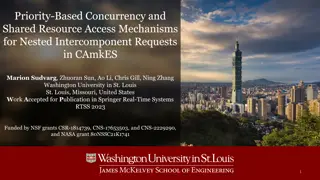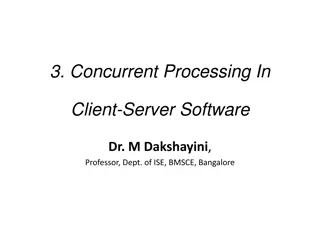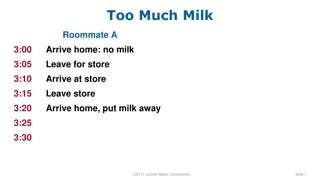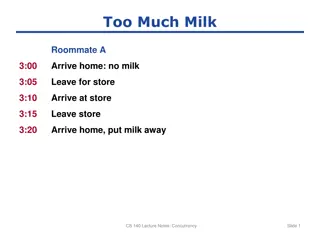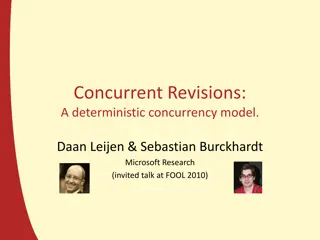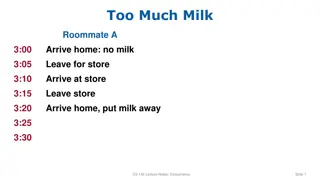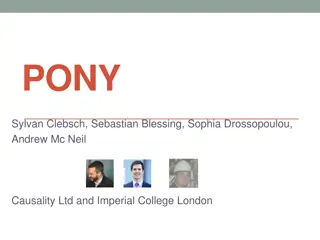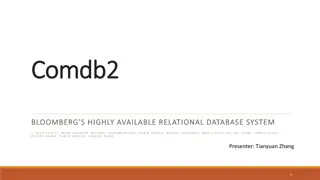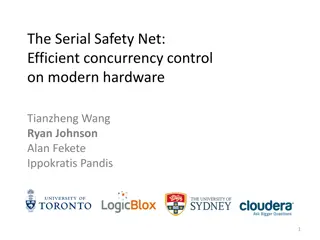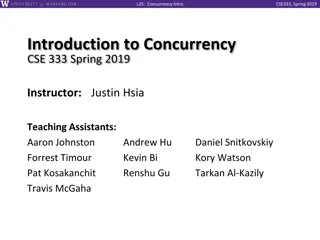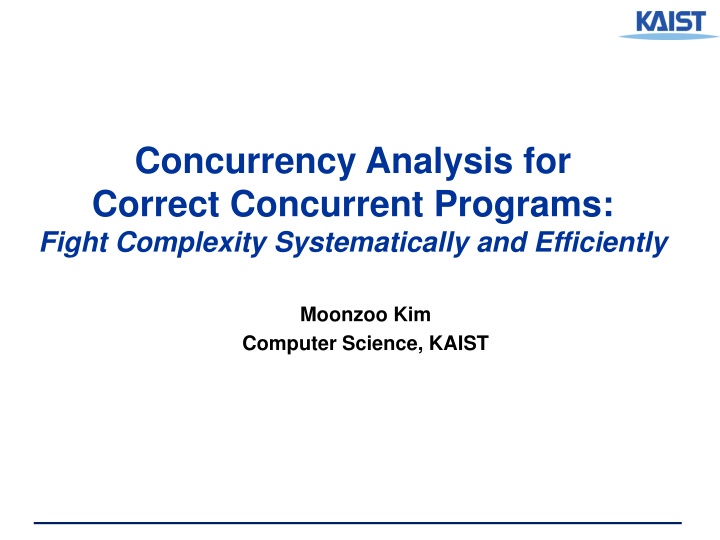
Concurrency Analysis for Correct Concurrent Programs
Explore the challenges in ensuring the correctness of concurrent programs, the complexity of non-deterministic scheduling, and the difficulties in detecting concurrency bugs. Learn how ubiquitous multi-core CPUs are shaping the future of software development.
Download Presentation

Please find below an Image/Link to download the presentation.
The content on the website is provided AS IS for your information and personal use only. It may not be sold, licensed, or shared on other websites without obtaining consent from the author. If you encounter any issues during the download, it is possible that the publisher has removed the file from their server.
You are allowed to download the files provided on this website for personal or commercial use, subject to the condition that they are used lawfully. All files are the property of their respective owners.
The content on the website is provided AS IS for your information and personal use only. It may not be sold, licensed, or shared on other websites without obtaining consent from the author.
E N D
Presentation Transcript
Concurrency Analysis for Correct Concurrent Programs: Fight Complexity Systematically and Efficiently Moonzoo Kim Computer Science, KAIST
Motivation for Concurrency Analysis Most of my subjects (interviewee) have found that the hardest bugs to track down are in concurrent code And almost every one seem to think that ubiquitous multi-core CPUs are going to force some serious changes in the way software is written P. Siebel, Coders at work (2009) -- interview with 15 top programmers of our times: Jamie Zawinski, Brad Fitzpatrick, Douglas Crockford, Brendan Eich, Joshua Bloch, Joe Armstrong, Simon Peyton Jones, Peter Norvig, Guy Steele, Dan Ingalls, L Peter Deutsch, Ken Thompson, Fran Allen, Bernie Cosell, Donald Knuth Unintended/unexpected thread scheduling (a.k.a., interleaving scenarios) raises hard to detect concurrency errors /37
Concurrent Programming is Error-prone Correctness of concurrent programs is hard to achieve Interactions between threads should be carefully performed A large # of thread executions due to non-deterministic thread scheduling Testing technique for sequential programs do not properly work 4 processes, 55043 states 3 processes, 853 states 2 processes , 30 states Ex. Peterson mutual exclusion (From Dr. Moritz Hammer s Visualisierung ) 3 / 30 SWTV group @ KAIST
Concurrency Concurrent programs have very high complexity due to non-deterministic scheduling Ex. int x=0, y=0, z =0; void p() {x=y+1; y=z+1; z= x+1;} void q() {y=z+1; z=x+1; x=y+1;} Total 20 interleaving scenarios = (3+3)!/(3!x3!) However, only 11 unique outcomes p() x=y+1 y=z+1 z=x+1 q() y=z+1 z=x+1 x=y+1 Trail1: 2,2,3 Trail2: 3,2,4 Trail3: 3,2,3 Trail4: 2,4,3 Trail5: 5,4,6 Trail6: 5,4,3 Trail7: 2,1,3 Trail8: 2,3,3 Trail9: 4,3,5 Trail10: 4,3,2 Trail11: 2,1,2 4/11
Very difficult to find concurrency bugs !!! 5/11 Moonzoo Kim
Operational Semantics of Software x:0,y:0 s0 A system execution is a sequence of states s0s1 A state has an environment s:Var-> Val A system has its semantics as a set of system executions x:0,y:1 s1 x:1,y:2 x:5,y:1 s2 s11 x:1,y:3 x:5,y:2 s3 s12 x:2,y:4 x:5,y:3 x:7,y:3 s4 s13 s21 x:5,y:4 x:7,y:4 s14 s22 6
Model Checker Analyzes All Possible Scheduling active type A() { byte x; again: x++; goto again; } x:0 x:1 x:2 x:255 active type A() { byte x; again: x++; goto again; } x:0,y:1 x:0,y:0 x:0,y:255 x:1,y:255 x:1,y:1 x:1,y:0 x:2,y:255 x:2,y:1 active type B() { byte y; again: y++; goto again; } x:2,y:0 x:255,y:255 x:255,y:0 7
Hierarchy of SW Coverage Criteria Complete Value Coverage CVC (SW) Model checking Complete Path Coverage CPC Concolic testing Prime Path Coverage PPC All-DU-Paths Coverage ADUP Edge-Pair Coverage EPC All-uses Coverage AUC Complete Round Trip Coverage CRTC Edge Coverage EC All-defs Coverage ADC Simple Round Trip Coverage SRTC Node Coverage NC 8/60

